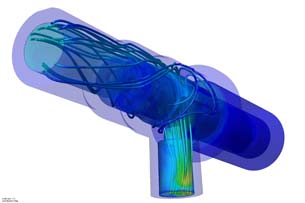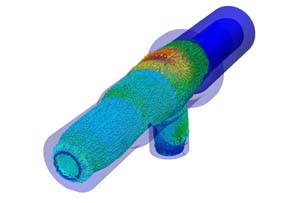Fast App: CFdesign Aids Development of Next-Gen Flow Sensors and Resistors
Developing a revolutionary IV infusion pump requires deviating from the well-beaten product-development path.
Latest News
May 24, 2010
By Ben Powers
 Figure 1. Fluidnet used CFdesign upfront CFD software to design a new generation of flow sensors and flow resistors for its new IV. (Courtesy of Fluidnet.) |
Fluidnet is revolutionizing the IV therapy market with a full-featured infusion pump that weighs less than 2 lb. and fits in the palm of your hand. The device is ultra-quiet and so efficient that it can operate on battery power for days. But the most revolutionary aspect is what goes on inside, and to develop that, the company needed upfront computational fluid dynamics (CFD) design software. Fluidnet used Blue Ridge Numerics’ CFdesign software to create a new generation of flow sensors and flow resistors for the administration set used with its IV pump (Figure 1).
CFdesign enables multi-tasking engineers to perform CFD analysis early in the design cycle, when it is most cost-effective to explore and validate designs. Virtual prototyping of different design options replaces traditional testing methods, saving the more costly physical prototyping for final design verification.
Expanding Dynamic Range
IV therapy must deliver fluids at rates from 0.1 ml/hr. to 6,000 ml/hr, an extremely large dynamic range for a mechanical system. The pressure required to move fluid in Fluidnet’s infusion pump could vary by a factor of only 3–4 times, which didn’t come close to allowing the full range of flow rates. So the company needed to find a means of adjusting fluidic resistance within the pump’s flow path by four orders of magnitude.
After extensive searching, the company could not find any stock resistive valves that would provide proportional control over the entire range. Then Fluidnet came up with a concept for a custom flow resistor that had the potential to perform in a purely logarithmic manner, which would provide proportional control over the full range of flow rates.
For example, if the resistor knob is rotated 10 degrees, the flow rate increases by about 10 times, no matter where the initial flow rate is set. With precise control and a large dynamic range, Fluidnet’s pump can keep fluidic driving pressures low, and low driving pressure translates into better safety for the patient receiving the infusion.
 Figure 2. Traces within a CFdesign simulation show the velocity of flow through the Fluidnet flow sensor and resistor. CFdesign provided a detailed internal performance picture of flow through tiny channels, providing information and insight not obtainable with even the most sophisticated physical test methods. (Courtesy of Fluidnet.) |
CFdesign allowed the company’s engineers to quickly iterate design versions and tweak dimensions to obtain the desired performance. When prototypes were built after the design was completed, the engineers found that the actual performance almost exactly matched the results predicted by CFdesign.
Real-Time Flow Observation
Fluidnet followed a similar path in developing its flow sensor. In this case, it needed an inline sensor that would provide a real-time flow measurement. The company refers to this as closed-loop flow control, which means you are continuously aware of how and what you are pumping. This window into flow is unique.
The sensor scheme Fluidnet chose is similar to a standard rotameter flow gauge, which uses a tapered tube and float to meter variable-area flow. But the company had to do extensive redesign to get the cost down and meet its exact requirements.
CFdesign allowed Fluidnet to iterate the design and assess performance changes associated with tolerance shifts (Figure 2). The company’s engineers could then optimize the design to fit their needs. Again, results predicted by CFdesign and actual results were almost dead on.
Upfront Time Savings
The design process for the flow resistor and sensor started with a simple design concept, such as a flow channel, wrapped in a helix, around a plunger. The concept was then modeled in SolidWorks. The company’s engineers did not model in great detail, but took care to capture the important parametric dimensions that affect flow.
From within SolidWorks, the engineers launched CFdesign, and it automatically opened the native geometry and created a fluid body that defined the flow path. The integration with SolidWorks was a huge plus—it probably cut the cycle time in half for each design-simulation iteration. With the model in CFdesign, the engineers meshed it and applied fluid properties and pressure or flow boundary conditions.
The design team then ran the analyses and reviewed the results. The goal for the flow resistor was to get a flow rate vs. pressure drop reading at a given resistor position. For the flow sensor, the engineers were looking to balance drag forces on a moving flow object with correcting forces of a retention spring.
 Figure 3. Vectors within a CFdesign simulation show pressure results through the narrow channel of the Fluidnet flow sensor and resistor. Fluidnet used CFdesign to adjust fluidic resistance within the flow path by four orders of magnitude. (Courtesy of Fluidnet.) |
In the flow sensor simulations, Fluidnet’s engineers brought the model into CFdesign, with the flow object in a specific position. They then ran a few analyses with different flow rates imposed on the system and assessed the resultant drag forces. The forces were then compared with the known spring restoring forces. When necessary, the flow rate was tweaked, and the analysis run again.
Fluidnet went through more than 10 different design concepts for both the flow sensor and resistor. Within the design concepts, there were also several stages of concept refinement, once the engineers chose the desired design direction. In the end, they probably went through hundreds of iterations, making the timesavings from CFdesign’s integration with SolidWorks and automatic creation of fluidic geometry especially significant.
One of the unique challenges the design team faced that made upfront CFD so valuable was the small flow channels—tapering from 0 to a 0.030-in. half circle—required by the design. At that scale, it’s difficult to intuitively picture what’s going on.
CFdesign provided a detailed internal picture of flow through tiny channels (Figure 3). This enabled the design team to predict performance and diagnose tooling errors.
In one case, the engineers saw strange behavior with some flow resistors that appeared to be related to a molding error. They modeled the error in SolidWorks, ran a CFdesign analysis, and were able to replicate the physical results they were seeing. The visualization of the error proved persuasive in getting the molder to fix the tool.
Saving Years and Millions
After the design refinements were complete, Fluidnet had single-cavity injection-molding tools made to test physical parts. The detail and geometry required for the application precluded standard SLA or machined prototypes. This is where the accuracy of CFdesign simulations came into play. Fluidnet only needed to produce one set of molds because the resultant parts performed as predicted in the simulations.
If the company had been forced to make molds for each of its guesses at the design, it would have had to go through many more rounds of tooling and would have ended up with inferior performance. Fluidnet also would have been way over budget and beyond its schedule. It would have taken years and more than a million dollars in tooling to get the same result.
A New Freedom
Fluidnet is currently doing clean-room builds of its disposable administration set, which includes the flow sensor and resistor, and finalizing the exterior pump design. The simplicity, portability, efficiency, and convenience of the pump will create a new freedom for care providers and patients.
Upfront CFD analysis enabled Fluidnet to create an accurate model of how its flow sensor and resistor really worked and identify the dimensions that would affect performance. That’s something that can’t be done with experience, intuition, or even an unlimited number of physical prototypes.
More Info
Blue Ridge Numerics
Ben Powers, system engineering manager for Fluidnet, managed simulation for the flow sensor and resistor projects. Larry Kuba, vice president of development, is the industrial designer behind the new pump, and Jeff Carlisle, CEO and founder, is the visionary behind the company. For more information, visit the company’s Web site.
Subscribe to our FREE magazine, FREE email newsletters or both!
Latest News
About the Author
DE’s editors contribute news and new product announcements to Digital Engineering.
Press releases may be sent to them via [email protected].






